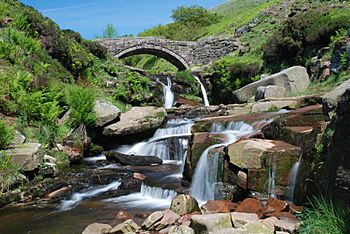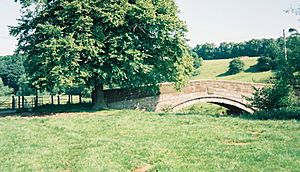River Dane facts for kids
Quick facts for kids River Dane |
|
|---|---|

The Dane at Three Shire Heads
|
|
| Country | England |
| Counties | Staffordshire, Cheshire, Derbyshire |
| Physical characteristics | |
| Main source | Axe Edge Moor |
| River mouth | Confluence with River Weaver |
| Basin features | |
| Tributaries |
|
The River Dane is a river in England that flows into the River Weaver. It starts in the beautiful Peak District area. The name "Dane" might come from an old Welsh word, dafn, which means "a drop or trickle". This suggests it was once seen as a slow-moving river.
Contents
Where the River Dane Flows
The River Dane begins its journey near the source of the River Goyt. This is just southwest of Buxton, at a spot called Dane Head on Axe Edge Moor.
Forming County Borders
As the river flows southwest, it creates a natural boundary. For about 10 kilometers (6 miles), it forms the border between Cheshire and Derbyshire. Then, it becomes the border between Cheshire and Staffordshire.
A special place along the river is called Three Shire Heads. This is where the three counties of Cheshire, Derbyshire, and Staffordshire all meet. It's a cool spot to visit!
Journey Through Cheshire
After forming these borders, the River Dane turns northwest. It flows through Cheshire, passing towns like Congleton and Holmes Chapel.
Near Middlewich, the Dane joins up with two other rivers. First, it meets the River Croco. Then, it connects with the River Wheelock near an aqueduct that carries the Trent and Mersey Canal.
The river then travels about 5 kilometers (3 miles) north to Northwich. Here, it finally flows into the River Weaver.
River Characteristics
Many people consider the River Dane to be the longest, cleanest, and fastest-flowing river in Cheshire.
You can even follow the river's path on a long walking route. The Dane Valley Way is a 48-mile (77-kilometer) trail that goes from Buxton all the way to Northwich, following the river as closely as possible.
Water's Journey to the Sea
Most of the water from the River Dane eventually reaches the Irish Sea. This is because it's part of the River Mersey system.
However, some of the water can be sent in a different direction. It can be moved through canals to Rudyard Lake and then into the Caldon Canal. This water eventually flows into the River Trent and then into the North Sea. This means some of the Dane's water crosses the main watershed of England!
Rivers Joining the Dane
A tributary is a smaller river or stream that flows into a larger river. The River Dane has many tributaries that add to its flow.
Here are some of the main rivers and streams that join the River Dane:
- Gad Brook
- Eldersbriar Brook
- Puddlinglake Brook
- River Wheelock
- River Croco
- Swettenham Brook
- Loach Brook
- The Howty
- Dane in Shaw Brook
- Cow Brook
- Ravensclough Brook
- Shell Brook
- Clough Brook
- Black Brook
- Flash Brook
- Robins Brook
- Three Shires Brook
History of the River Dane
The River Dane has played an important role in the history of the areas it flows through.
Bridges and Viaducts
You can see a very tall red brick railway bridge, called the Twemlow Viaduct, crossing the wide Dane Valley. It was built in 1841 and has 23 arches. It's so important that it's protected as a Scheduled monument. This viaduct crosses the river at Saltersford, where salt traders used to drive their carts through a ford.
Not far from there, you'll find the smaller stone Hermitage Bridge, which was built in 1772. Sometimes, the river can flood the meadows widely around this area.
Floods and Industry
In 1451, the River Dane flooded badly in Congleton. This flood destroyed the town's corn mill, many timber-framed buildings, and the wooden bridge over the river. To stop this from happening again, the river was moved away from the town.
Congleton's textile industry grew a lot starting in the 1300s. By the 1700s, many mills that used water power were built along the river to help make textiles.
Many of the old bridges over the River Dane are now protected because of their historical importance. These include the Macclesfield Canal Aqueduct (built in 1830) and the Congleton Railway Viaduct (built in 1849).
|



